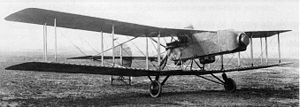Royal Aircraft Factory N.E.1 Video - Picture

|
|
Royal Aircraft Factory N.E.1
N.E.1

Picture - The first prototype N.E.1 in its original configuration, with a searchlight in the nose
Role: Night Fighter
National origin: United Kingdom
Manufacturer: Royal Aircraft Factory
First flight: 8 September 1917
Number built: 6
Developed from: Royal Aircraft Factory F.E.9
Variants: Royal Aircraft Factory A.E.3
The Royal Aircraft Factory N.E.1 was a prototype British Night fighter of the First World War. A single engined pusher biplane, it was a development of the Royal Aircraft Factory's earlier F.E.9 fighter, but was not successful, only six being built.
Development and design
In 1917, the British Royal Aircraft Factory started design of a night fighter development of its F.E.9, the F.E.12. This used the tailbooms, undercarriage and wing centre-sections of the F.E.9, combining them with new, three-bay outer wings and a larger tailplane. It was to be armed with a shell firing gun and equipped with two searchlights. The design was revised to produce the N.E.1 (for Night-flying Experimental), with revised wings, new tailbooms and a new, wide track, undercarriage.
The first prototype N.E.1 flew on 8 September 1917. It was fitted with a single searchlight in the nose, and with the pilot and gunner sat in tandem, with the pilot seated in front to give a good view. The gunner was to be armed with a 1.59-inch (40-mm) Breech-Loading Vickers Q.F. Gun, Mk II -- widely known as the "Vickers-Crayford rocket gun," although it had no rocket-launching capability -- or a 1½ lb COW gun, and a radio was fitted. It was powered by a 200 hp (149 kW) Hispano-Suiza 8 engine in a pusher configuration driving a four bladed propeller. Its three-bay equal span wings were fitted with ailerons on both upper and lower wings, while the elevators had large horn balances (the amount of control surface forward of the hinge).
The first prototype crashed on 14 September 1917, and was rebuilt with a new nacelle with the searchlight removed, and the gunner, who was armed with a 1.59-inch (40-mm) Breech-Loading Vickers Q.F. Gun, Mk II, moved ahead of the pilot. A fixed Lewis gun was mounted externally on the starboard side of the fuselage, to be operated by the pilot. It reflew in this form on 4 October 1917.
Although testing indicated that the N.E.1 was easy to fly and land, and had excellent field of fire for the gunner, the official test report noted "It is doubtful if the performance of this machine is good enough to make it suitable as a night fighter". Despite this, all six prototypes were completed, with the second prototype being sent to No. 78 Squadron, while several of the other aircraft were used for trials.
Operators
United Kingdom
Royal Flying Corps
No. 78 Squadron RFC
Specifications
Data from British Aeroplanes 1914-18
General characteristics
Crew: 2
Length: 28 ft 6 in (8.67 m)
Wingspan: 47 ft 10 in (14.58 m)
Height: 9 ft 8 in (2.95 m)
Wing area: 555 sq ft (51.6 m²)
Empty weight: 2,071 lb (941 kg)
Loaded weight: 2,946 lb (1,339 kg)
Powerplant: 1x— Hispano-Suiza 8 water-cooled V8 engine, 200 hp (149 kW)
Performance
Maximum speed: 95 mph (83 knots, 153 km/h) at 10,000 ft (3,050 m)
Service ceiling: 17,500 ft (5,540 m)
Endurance: 2¾ hours
Climb to 5,000 ft (1,520 m): 9 min
Climb to 10,000 ft (3,050 m): 22 min
Climb to 18,000 ft (5,490 m): 81 min 25 sec
Armament
Guns:
1x— 1.59-inch (40 mm) Breech-Loading Vickers Q.F. Gun, Mk II
1x— .303 in Lewis gun
Related development
Royal Aircraft Factory F.E.9
Royal Aircraft Factory A.E.3
Comparable aircraft
Vickers F.B.25
The Vickers-Crayford, although called the "rocket gun," was a lightweight single shot 40-mm gun that fired shells. It was officially known as the 1.59-inch Breech-Loading Vickers Q.F. Gun, Mk II.
Bruce, J.M. British Aeroplanes 1914-18. London:Putnam, 1957.
Bruce, J.M. War Planes of the First World War: Volume Two Fighters. London:Macdonald, 1968. ISBN 0 356 01473 8.
Lewis, Peter. The British Fighter since 1912. London:Putnam, 1979. ISBN 0 370 10049 2.
Mason, Francis K. The British Fighter since 1912. Annapolis, Maryland, USA:Naval Institute Press, 1992. ISBN 1-55750-082-7.
Williams, Anthony G. and Gustin, Emmanuel. Flying Guns: World War I and its Aftermath 1914-32. Ramsbury, UK:Airlife, 2003. ISBN 1 84037 396 2.
Royal Aircraft Factory N.E.1 Pictures
Living Warbirds: The best warbirds DVD series.
Source: WikiPedia